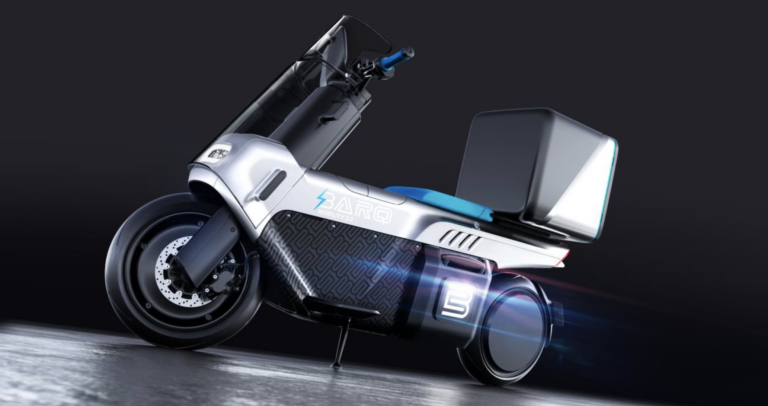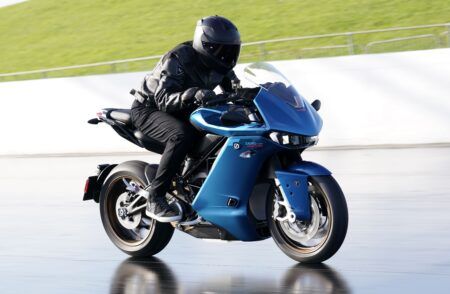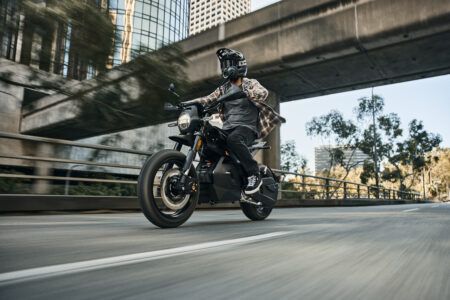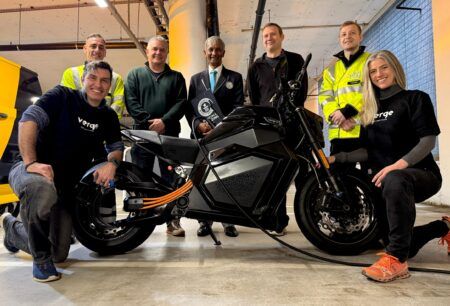A modern electric scooter, created specifically to respond to rising demand for last mile deliveries in Middle East and North African (MENA) markets, has been designed and engineered by Callum for mobility solutions provider Barq.
As Barq’s first vehicle, Callum determined Rena Max should have a striking identity and be instantly recognizable. This led to an innovative form that allows for class-leading rider comfort, swappable battery technology and unlocked additional storage in front of the user.
After receiving a clear brief from Barq on its requirements, Callum opted for 5.6KwH swappable Lithium-Ion batteries that avoid lengthy idle charging times and offer a range of up to 150km. Multiple modes (Eco, City, Sport and a Reverse Gear) for the 7KW motor enable a blend of efficiency, performance and convenience.
To maximize convenience Callum created three storage compartments. Behind the rider, a versatile 79-liter back box with a standardized Givi mounting system offers adjustable shelving and passive insulation with a food-safe lining. This is complemented by a nine-liter cool box and a five-liter user storage area up front. To achieve this Callum developed a novel front structure in lieu of the traditional step-through seating found on existing converted scooters.
“Unconstrained, we had the opportunity to create a modern, functional and intelligent design,” says Callum’s creative lead, Aleck Jones. “We built a buck to see how this new arrangement would suit riders of all shapes and sizes. The feedback was overwhelmingly positive. This design was universally popular for comfort and convenience, and for invoking a style of riding more akin to a motorbike.” This layout enabled Callum to maximize carrying capacity and convenience. “Riders said it was important to carry enough fluids to stay hydrated for their whole round,” adds Jones. “So, we created a personal stowage area for their drinks bottle and belongings with further capacity to carry a pair of two-liter bottles or large fast-food cups upright.”
Other features include an easy-to-reach, ruggedized, 8in Samsung Galaxy Tab Active3 touchscreen. “Riders usually get their route information on a handheld device. That’s neither easy to follow nor glance at. It led us to prioritize the touchscreen in the dash layout with a specified mounting angle that minimizes glare and reflections,” says Jones.
Factoring in the harsh environment the Rena Max is expected to perform in and with input from Barq, Callum introduced further thoughtful design touches to cope with the heat. Callum’s in-house Color and Materials Team specified perforated light blue polyurethane handlebar grips and a diamante textured vinyl blue seat that are cooler to the touch. Both body panel color options are UV resistant to keep Rena Max looking good for longer and are modular to allow scratched or damaged sections to be refreshed swiftly. Tubeless 13in and 14in tires minimize punctures, even on unpaved roads. As security is a factor for unattended vehicles during drop-offs, an electronically controlled locking system logs and tracks all openings of the backbox. With an eye to future use cases, Callum has made a modular architecture to offer seating options for a pillion.
“Callum is about creating bespoke solutions that are a potent blend of design and engineering expertise,” adds Ian Callum, who oversaw the Barq project with the growing Callum team in Warwick. “Rena Max has a sense of style that is sometimes forgotten with future mobility solutions.”
Production is expected to take place in the MENA region, where the Max is scheduled to be deployed.





